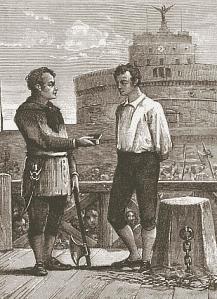Giovanni Battista Bugatti

Giovanni Battista Bugatti (* 1779 , † 1869 ) was the official executioner of the Papal States from 1796 to 1864. He was the executioner (officially maestro di giustizia , Justice champion or champions of justice ) with the longest service in the Papal States and was nicknamed Mastro Titta (familial for Battista ). At the age of 85 he was taken over by Pope Pius IX. retired with a monthly pension of 30 scudi . His successor during the years up to 1868 (last execution in the Papal States on November 24th) was his previous assistant Vincenzo Balducci .
Act

Bugatti described his executions as justice and the convicts as patients . The first execution he carried out took place on March 22, 1796. Until the introduction of the guillotine by the French occupying forces, beheading with an ax or hanging was the method of execution. The first guillotination took place on February 28, 1810. A woman was executed for poisoning her husband when she found out he had a lover. The guillotine stood - or the place of execution was, as shown in the picture - on the Angel's Bridge . When the Papal States regained their sovereignty in 1816, the guillotine continued to be used (first guillotination under papal government on October 2, 1816).
Bugatti carried out a total of 516 executions. His service income consisted of an apartment and a share of certain state taxes, regardless of the number of executions. For the actual execution he only received a symbolic wage of 3 centesimi each (= 0.03 lire ). This was meant to say that he didn't kill for the money.
He is described as small and stately and always well dressed. He attended the Church of Santa Maria in Traspontina , was married but had no children. In addition to his work for the judiciary, he painted umbrellas a. a. with portraits of the pope that were sold to pilgrims and tourists.
He was only allowed to leave the Trastevere district , where he lived, for official business. Officially, this was for his own protection in the event that family members of those he executed wanted to take revenge on him. But this must also have something to do with the superstition associated with his activity. But when Mastro Titta crossed the bridge, it meant to the Romans that an execution was imminent, and people gathered to watch the popular spectacle.
One of his executions, which took place on March 8, 1845, is described by Charles Dickens in his work Pictures From Italy .
Bugatti's blood-stained cloak, axes and guillotine are on display in the Criminal Museum in Rome (Museo Criminologico, Via del Gonfalone 29). The guillotine is of a very peculiar design (straight instead of angled cutting edge; bezel V-shaped instead of semicircular).
His execution directory , the Annotationes , closes with the entry: “This is where Bugatti's list ends. May that of his successors be shorter. "
literature
- Susan Vandiver Nicassio: Tosca's Rome: The Play and the Opera in Historical Perspective . Chicago 1999, 2001, p. 187
swell
- He executed justice. 14 September 2001 National Catholic Reporter (English) ( Memento of 11 March 2007 at the Internet Archive )
- When Mastro Titta Crossed The Bridge. Excerpt from Charles Dickens: Pictures From Italy, 1846 (English) ( Memento from December 26, 2007 in the Internet Archive )
- Mastro Titta, il boia di Roma . Autobiography of "Mastro Titta" (Italian)
- Thomas K. Wukitsch: Mastro Titta. (English)
Web links
- Mantello appartenuto al boia dello Stato Pontificio. Site of the Museo Criminologico, Rome (Italian)
Individual evidence
- ^ See Augsburgische Ordinari Postzeitung, Nro. Saturday, Jan. 20, Anno 1810, p. 1.
- ↑ 516 Orders for the Pope's executioner. Die Welt , July 9, 2014.
| personal data | |
|---|---|
| SURNAME | Bugatti, Giovanni Battista |
| BRIEF DESCRIPTION | Italian executioner in the Papal States |
| DATE OF BIRTH | 1779 |
| DATE OF DEATH | 1869 |